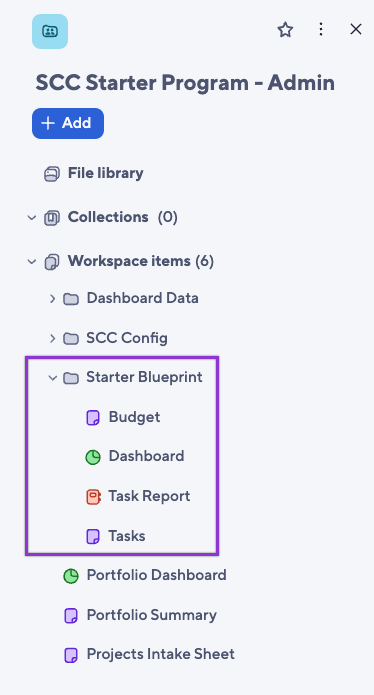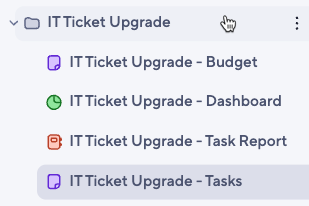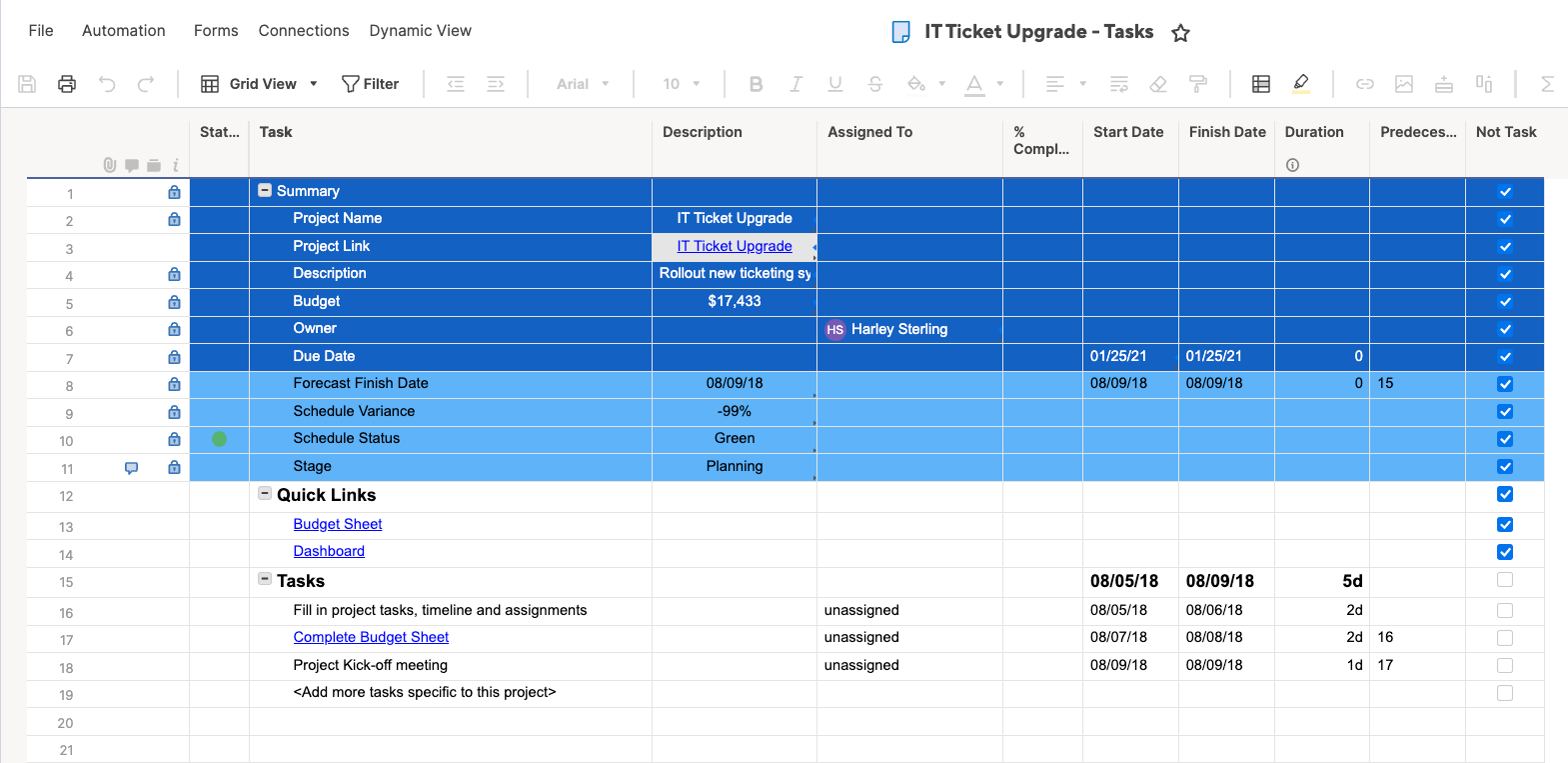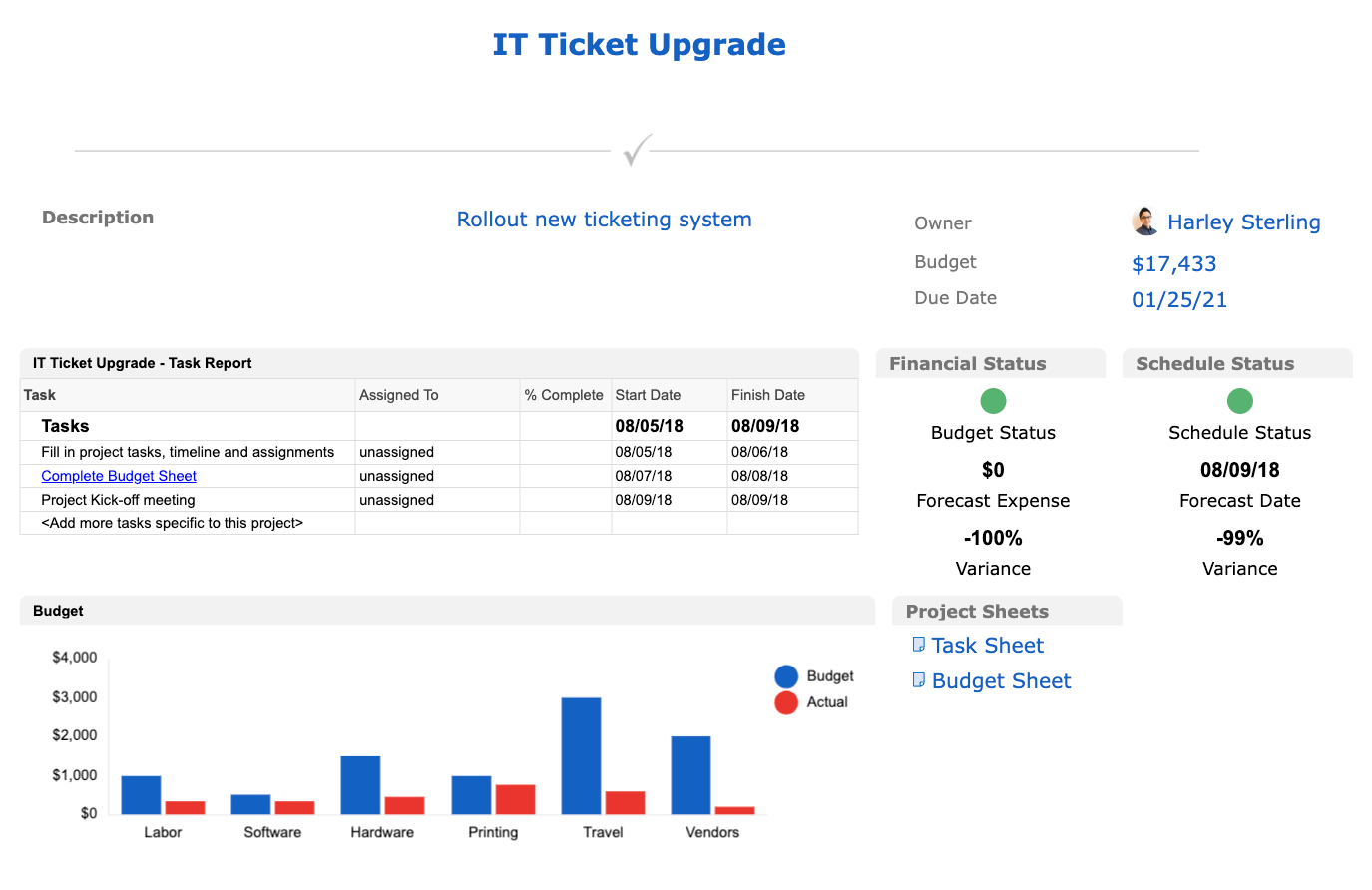The blueprint source folder contains templates for the sheets, reports, and dashboards that are created each time you add a project. Templates help standardize business processes followed by every project, maintaining consistency in execution and reporting.
Templates are the building blocks for a blueprint. The blueprint source folder must include at least one template.
Blueprints can also include multiple sheets, reports, and dashboards. Use cell links, cross-sheet formulas, and hyperlinks to share information and create an integrated set of templates.
Name your blueprint source folder and templates
- Name your blueprint source folder after the business process you want to track (some examples include: Installation, IT Project, Store Opening, Customer Account). When you create your project folders from the blueprint, they inherit the folder name and have the same project-specific prefixes or suffixes added.
Profile data fields shouldn’t match the name of the templates. If your template names or the blueprint source folder name changes, make sure to update it in the blueprint builder.
- Name individual templates based on their function (some examples include: Tasks, Budget, Dashboard, Milestone Report).
When you create the project, you can add prefixes or suffixes to better identify them.
This is what your blueprint source folder containing your templates looks like:

This is what your project folder with project-specific sheets looks like:

Keep the following tips in mind:
- Place your blueprint source folder in the Admin workspace. Limit access to the folder so only Program Leads can make changes.
- Templates can be optional. When you create a blueprint, you can specify which templates are optional or required.
- Control Center allows up to 75 templates.
Anatomy of a sheet template
A sheet template contains the structure followed each time you use the blueprint.
Summary section (Profile data)

Profile data is populated from the intake sheet and appears in the upper portion of your template sheets under a parent row called Summary. The Summary section must follow the rules for profile data.
You can format the summary data rows to highlight profile data. To do this, set the formatting in your templates before you create new projects.
It’s possible to create placeholder values for intake profile data, using the format <<value here>>. When you create a project, update the placeholders with the correct values. Placeholders help you find errors or omissions when you create a blueprint.
Save your blueprint templates as sheets, not as Smartsheet templates.
Quick links
Optional links provide users with a quick method of switching between items in the project.
Tasks
The task section is where your work happens. Sheets are flexible. Create as many rows or columns as you need (within Smartsheet limits).
Business processes appear after the profile data section. Your process may be a task list with a schedule, an issues tracker, or a budget. The actual tasks depend on your needs and the desired end goal.
You can use profile data to customize the task—you may want to name cells with the business name or track budget items in the business process section of the sheet.
Report templates
Reports provide a single, focused data view from one or more sheets. When you create a report template, you ensure that the same criteria are used for each instance of a report that becomes created from that blueprint at scale.
For example, you could create a report template to display all tasks assigned to someone across all sheets generated from the blueprint.
Dashboard templates
Dashboards provide an overview of a project, and they’re a snapshot presenting key parts to stakeholders. A dashboard can also act as the front page of your project, displaying important information in one place and providing links to essential sheets and reports.

The dashboard template pulls information from sheets in your blueprint source folder. Use placeholder data in the templates to help with design and layout.
Any changes you make to your dashboard template in the blueprint source folder appear across all existing projects. Updates made with the Global Updates feature don't change existing dashboards.
When you provision a project containing a dashboard with a shortcut widget or a web content widget that includes a form URL, the form URL gets updated if the form is connected to a sheet that’s a part of the blueprint template. The form URL remains the same if the form is connected to a sheet that isn’t part of the blueprint template.
Be sure to update the blueprint builder if you add, remove, or rename dashboard templates in the blueprint source folder.
Keep the following tips in mind:
- Only use title, rich text, and image widgets when you know they're identical across all projects (for example, use them for instructions or graphics).
- Use a metric widget to reference profile data cells on template sheets. (If you don’t use a metric widget, you have to manually update the widgets after the project is created).
Add, remove, or change templates
When a project changes, you may need to add a new template or update existing ones.
Add a new template
- In Smartsheet, open the workspace panel or select Home > All workspaces to navigate to the blueprint source folder.
- Open the workspace, select Add, and create a new sheet, report, or dashboard. Structure it as desired.
- In Control Center, update the blueprint builder.
Make changes to an existing template
To change a template for all subsequent projects:
- In Smartsheet, open the workspace panel or select Home > All workspaces to navigate to the blueprint source folder.
- Open the item to edit.
- Add your changes and save the item.
To change a template for all existing projects using Global Updates:
- In Control Center, open the program to update and select Manage Program.
- Select Global Updates > New Update in the upper-right corner of the Control Center window.
Keep the following tips in mind:
- When you add or remove templates, update the blueprint builder so new projects reflect your changes.
- When adding new templates to your portfolio, add them as Optional - Selected in your Source Template Settings and then manually add them to each existing provisioned project. Then, make the new templates required for all new projects moving forward. If you need to provision new projects before adding the templates to all existing projects, you need to manually select this new template during provisioning.
- Don’t change the name of already provisioned projects to the new template name. If you do so, Global Updates can’t find the projects.
- Adding a new project sheet template doesn’t remove the previous one from the already provisioned projects. Make sure you don’t use the same name for both templates.
- Refresh your folder if you're not seeing your changes.